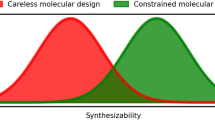Abstract
This paper describes the extension of our earlier multiobjective method for generating plausible pharmacophore hypotheses to incorporate partial matches. Diverse sets of molecules rarely adopt exactly the same binding mode, and so allowing the identification of partial matches allows our program to be applied to larger and more diverse datasets. The method explores the conformational space of a series of ligands simultaneously with their alignment using a multiobjective genetic algorithm (MOGA). The principles of Pareto ranking are used to evolve a diverse set of pharmacophore hypotheses that are optimised on conformational energy of the ligands, the goodness of the overlay and the volume of the overlay. A partial match is defined as a pharmacophoric feature that is present in at least two, but not all, of the ligands in the set. The number of ligands that map to a given pharmacophore point is taken into account when evaluating an overlay. The method is applied to a number of test cases extracted from the Protein Data Bank (PDB) where the true overlay is known.







Similar content being viewed by others
References
Güner OF (ed) (2000) Pharmacophore perception, development and use in drug design. International University Line, La Jolla, CA
Jones G, Willett P, Glen RC (1995) J Comput Aided Mol Des 9:532
Barnum D, Greene J, Smellie A, Sprague P (1996) J Chem Inf Comput Sci 36:563
Martin YC, Bures MG, Danaher EA, Delazzer J, Lico I, Pavlik PA (1993) J Comput Aided Mol Des 7:83
Patel Y, Gillet VJ, Bravi G, Leach AR (2002) J Comput Aided Mol Des 16:653
van Drie JH (2003) Curr Pharm Design 9:1649
Richmond NJ, Willett P, Clark RD (2004) J Mol Graphics Model 23:199
Feng J, Sanil A, Young SS (2006) J Chem Inf Model 46:1352
Cottrell SJ, Gillet VJ, Taylor R, Wilton DJ (2004) J Comput Aided Mol Des 18:665
Galahad. Tripos Inc. (1699) South Hanley Rd, St. Louis, Missouri, 63144, USA
Goldberg DE (1989) Genetic algorithms in search, optimization and machine learning. Wokingham, Addison-Wesley
Fonseca CM, Fleming PJ (1998) IEEE Trans Syst Man Cybern A – Syst Humans 28:26
Handschuh S, Wagener M, Gasteiger J (1998) J Chem Inf Comput Sci 32:220
Gillet VJ, Khatib W, Willett P, Fleming PJ, Green DVS (2002) J Chem Inf Comput Sci 42:375
Nicolotti O, Gillet VJ, Fleming PJ, Green DVS (2002) J Med Chem 45:5069
Brown N, McKay B, Gasteiger J (2004) J Comput Aided Mol Des 18:761
Catalyst. Accelrys, 9685 Scranton Road, San Diego, CA 92121, USA
Berman HM, Battistuz T, Bhat TN, Blum WF, Bourne PE, Burkhardt K, Feng Z, Gilliland GL, Iype L, Jain S, Fagan P, Marvin J, Padilla D, Ravichandran V, Schneider B, Thanki N, Weissig H, Westbrook JD, Zardecki C (2002) Acta Crystallogr D58:899
Sutcliffe MJ, Haneef I, Carney D, Blundell TL (1987) Protein Eng 1:377
Kabsch W (1976) Acta Crystallogr A 32:922
Raymond JW, Willett P (2003) J Chem Inf Comput Sci 43:908
Supuran CT, Scozzafava A (2002) Expert Opin Therapeut Patents 12:217
Hendlich M, Bergner A, Gunther J, Klebe G (2003) J Mol Biol 326:607
Tu CK, Silverman DN, Forsman C, Jonsson BH, Lindskog S (1989) Biochemistry 28:7913
Abbate F, Supuran CT, Scozzafava A, Orioli P, Stubbs MT, Klebe G (2002) J Med Chem 45:3583
Sielecki TM, Boylan JF, Benfield PA, Trainor GL (2000) J Med Chem 43:1
Davies TG, Bentley J, Arris CE, Boyle FT, Curtin NJ, Endicott JA, Gibson AE, Golding BT, Griffin RJ, Hardcastle IR, Jewsbury P, Johnson LN, Mesguiche V, Newell DR, Noble MEM, Tucker JA, Wang L, Whitfield H (2002) J Nat Struct Biol 9:745
Mestres J, Rohrer DC, Maggiora GM (1997) J Comput Chem 18:934
Gerber PR, Muller K (1987) Acta Crystallogr A 43:426
Kearsley SK (1990) J Comput Chem 11:1187
Author information
Authors and Affiliations
Corresponding author
Rights and permissions
About this article
Cite this article
Cottrell, S.J., Gillet, V.J. & Taylor, R. Incorporating partial matches within multiobjective pharmacophore identification. J Comput Aided Mol Des 20, 735–749 (2006). https://doi.org/10.1007/s10822-006-9086-7
Received:
Accepted:
Published:
Issue Date:
DOI: https://doi.org/10.1007/s10822-006-9086-7




